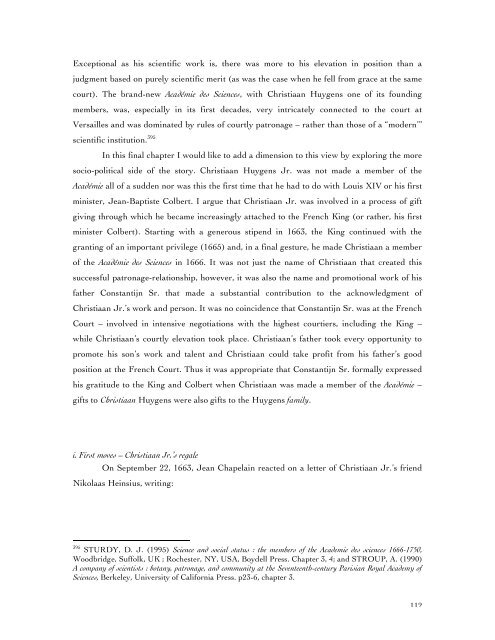Christiaan Huygens – A family affair - Proeven van Vroeger
Christiaan Huygens – A family affair - Proeven van Vroeger
Christiaan Huygens – A family affair - Proeven van Vroeger
You also want an ePaper? Increase the reach of your titles
YUMPU automatically turns print PDFs into web optimized ePapers that Google loves.
Exceptional as his scientific work is, there was more to his elevation in position than a<br />
judgment based on purely scientific merit (as was the case when he fell from grace at the same<br />
court). The brand-new Académie des Sciences, with <strong>Christiaan</strong> <strong>Huygens</strong> one of its founding<br />
members, was, especially in its first decades, very intricately connected to the court at<br />
Versailles and was dominated by rules of courtly patronage <strong>–</strong> rather than those of a “modern’”<br />
scientific institution. 395<br />
In this final chapter I would like to add a dimension to this view by exploring the more<br />
socio-political side of the story. <strong>Christiaan</strong> <strong>Huygens</strong> Jr. was not made a member of the<br />
Académie all of a sudden nor was this the first time that he had to do with Louis XIV or his first<br />
minister, Jean-Baptiste Colbert. I argue that <strong>Christiaan</strong> Jr. was involved in a process of gift<br />
giving through which he became increasingly attached to the French King (or rather, his first<br />
minister Colbert). Starting with a generous stipend in 1663, the King continued with the<br />
granting of an important privilege (1665) and, in a final gesture, he made <strong>Christiaan</strong> a member<br />
of the Académie des Sciences in 1666. It was not just the name of <strong>Christiaan</strong> that created this<br />
successful patronage-relationship, however, it was also the name and promotional work of his<br />
father Constantijn Sr. that made a substantial contribution to the acknowledgment of<br />
<strong>Christiaan</strong> Jr.’s work and person. It was no coincidence that Constantijn Sr. was at the French<br />
Court <strong>–</strong> involved in intensive negotiations with the highest courtiers, including the King <strong>–</strong><br />
while <strong>Christiaan</strong>’s courtly elevation took place. <strong>Christiaan</strong>’s father took every opportunity to<br />
promote his son’s work and talent and <strong>Christiaan</strong> could take profit from his father’s good<br />
position at the French Court. Thus it was appropriate that Constantijn Sr. formally expressed<br />
his gratitude to the King and Colbert when <strong>Christiaan</strong> was made a member of the Académie <strong>–</strong><br />
gifts to <strong>Christiaan</strong> <strong>Huygens</strong> were also gifts to the <strong>Huygens</strong> <strong>family</strong>.<br />
i. First moves <strong>–</strong> <strong>Christiaan</strong> Jr.’s regale<br />
On September 22, 1663, Jean Chapelain reacted on a letter of <strong>Christiaan</strong> Jr.’s friend<br />
Nikolaas Heinsius, writing:<br />
395 STURDY, D. J. (1995) Science and social status : the members of the Academie des sciences 1666-1750,<br />
Woodbridge, Suffolk, UK ; Rochester, NY, USA, Boydell Press. Chapter 3, 4; and STROUP, A. (1990)<br />
A company of scientists : botany, patronage, and community at the Seventeenth-century Parisian Royal Academy of<br />
Sciences, Berkeley, University of California Press. p23-6, chapter 3.<br />
112


